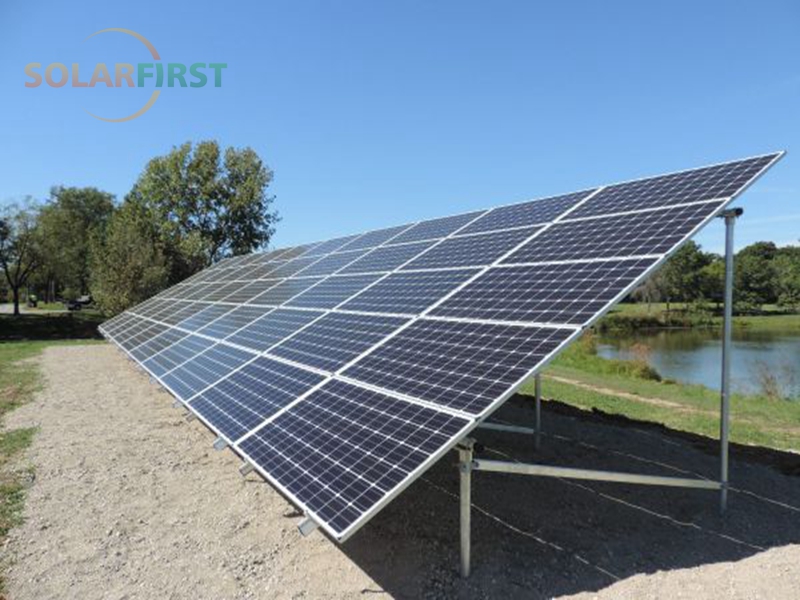In many cases, ground mounting solar systems can be your best choice.
The reasons are as follow:
1.Ground mounting solar systems can be located in the best way with any conditions.
If your house needs lots of electricity, your roof might not be big enough for a solar energy system which meets your electricity needs. In contrast, ground mounting solar systems can be sized to match your electricity consumption without the space restrictions of a rooftop system.
2. Ground mounting solar systems are very easy to place.
Since they can be located on open land. They don’t require drilling into your roof or anywhere else, and the bracing used in standard ground mounting systems are lightweight and easy to remove.
3. A Ground mounting solar system can be set at the perfect angle to optimize energy production.
4. Ground mounting solar systems are very easy to access for cleaning and maintenance.
If you live in an area that receives a lot of snow in the winter, being able to easily sweep the snow off of your solar panels is a major convenience.
Having said so many advantages, we knew that we can benefit from the use of ground mounting solar systems, but which one to choose?
Now, let’s move on to the most popular types of ground mounting systems.
Ground mounting arrays range in size from small residential less than 10KW to large utility solutions upwards of 1 MW or beyond. Within that range, there are many ground mounting options available to meet the needs of almost any site and any project.
Ground mounting arrays are installed at grade on galvanized steel or aluminum support structures. The support structures are bound to the earth using ground mounting foundations, which are consisting of driven piles, helical piles, ground screws, concrete footings, concrete ballast or a mixture of these components.
The type of ground mounting foundation used is based mainly on soil properties as well as the geometry of the foundation. (There are two basic types of ground mounting foundations geometries, single post and double posts.)
The following briefly describes each foundation:
a. Driven piles are commonly found in large projects.
The piles are constructed of galvanized steel I beams, channel-shaped steel or posts. The piles are driven into the ground using special heavy machinery. Proper soil conditions must be present for driving piles. These conditions include good soil cohesion resulting in high pullout strength as well as limited refusal.
b. Helical piles are a galvanized steel post with a split disc welded to the bottom at an angle to allow the ground mounting foundation to move deeper as the post is rotated and driven down. It use machinery with auger drive units to install these foundations. Sandy soils with low cohesion and high water tables are good fits for helical piles.
c. Ground screws, as the name implies, are large galvanized steel posts with welded or machined threads. Similar to helical pile installations, ground screw installations utilize auger attachments on Solar First Mounting Systems, using machinery to drive the ground screw into the ground. However, it is common to pre-drill pilot holes when rock or dense refusal is present. Ground screws are a good fit when soil / ground conditions have high amounts of rock, ledge or refusal.
d. Poured concrete footings are very common especially among small ground mounting installations. These ground mounting foundations consist of a galvanized steel post embedded in a concrete form dug into the earth. They are more common to smaller projects because digging holes, aligning posts and handling concrete usually requires a fair amount of labor.
e. Ballasted ground mounting foundations are those where pre-cast or poured-in-place concrete ballasts are utilized to support the racking structure. These ground mounting foundations are good candidates when high amounts of refusal are present or when soil conditions have poor lateral and vertical strength such as brown fields.
In general, ground mounting solar systems are available in a variety of designs that work with many different ground mounting foundations to meet the requirements of almost any site. After performing a thorough site assessment and Geo-technical study, you can determine the the best ground mounting solution for your project.

 online service
online service +86 592-5211-388
+86 592-5211-388 info@esolarfirst.com
info@esolarfirst.com sales004_solarfirst
sales004_solarfirst sales12_solarfirst
sales12_solarfirst sales10_solarfirst
sales10_solarfirst +86 18959208686
+86 18959208686